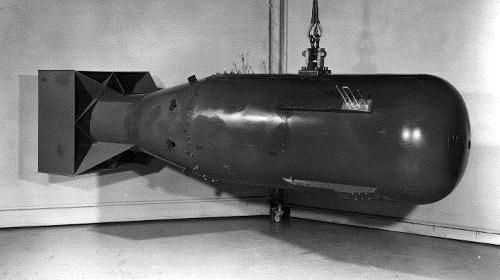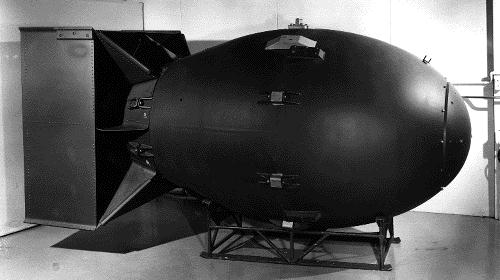Nuclear Bombs
- There are two main types of nuclear bombs: atom bombs and hydrogen
bombs.
- In either type of bomb, a nuclear chain reaction occurs because the nuclear
material has reached critical mass.
- Critical mass occurs when the chain reaction of fissioning or fusing atoms
is self-sustaining.
- Reaching critical mass
- There are two ways to have nuclear material reach critical
mass: through high density of atoms or through just having large numbers
of atoms.
- To make things simple let's experiment with some atoms going through
the fission process. Click on the image below to explore reaching critical
mass.
- Atom Bombs
- Atom bombs are made from either Uranium-235 or Plutonium-239
which fission spontaneously.
- Critical mass can be reached by putting enough Uranium-235 in one place
so that enough neutrons which are emitted continue the chain reaction,
causing more atoms to fission. This type of nuclear weapon is very simple.
If you have enough Uranium-235 in one place it will explode with a force
of thousands of tons of dynamite.
- Below is a picture of the bomb dropped on Hiroshima, Japan during the
second world war.
- Inside the bomb are two pieces of Uranium. At the moment of explosion
the two pieces are brought together causing there to be enough fissioning
uranium atoms to cause an out of control chain reaction.
- This one bomb released an explosion equivalent to 25,000 pounds of TNT.
It killed between 80,000 to 140,000 people, while injuring 100,000 more
very seriously.
- Another way to make an atom bomb is to surround a sphere of Plutonium-239
with normal explosives so that they will squeeze the plutonium atoms into
a mass of very dense atoms, causing critical mass and a sustained chain
reaction that quickly gets out of control.
- The nuclear bomb dropped on Nagasaki three days later is depicted below
is a plutonium bomb:
- Hydrogen Bombs
- Hydrogen bombs use fusion instead of fission to generate their
explosions.
- While uranium and plutonium spontaneously fission to produce energy,
hydrogen atoms resist very strongly the urge to fuse.
- The nuclei of hydrogen atoms is positive. Like charges repel, so it
is very difficult to get the nuclei of atoms to fuse.
- The only way to do it is to slam the atoms together with enough force
to make them fuse. Temperatures of over 50 million degrees are necessary
to make this happen. Of course, the sun has no problem maintaining these
temperatures in its core, but achieving those high temperatures here on
Earth is very difficult.
- In order to get the hydrogen atoms to fuse together, a fission type
atom bomb must be exploded first, generating the intense heat an pressure
necessary to fuse the hydrogen atoms.
- This is the reason all nuclear power plants use the fission process.
Fission happens spontaneously without the need for extreme temperatures
and pressures. People are working on making a fusion type reactor, but
a working controlled fusion reactor is many decades away.


